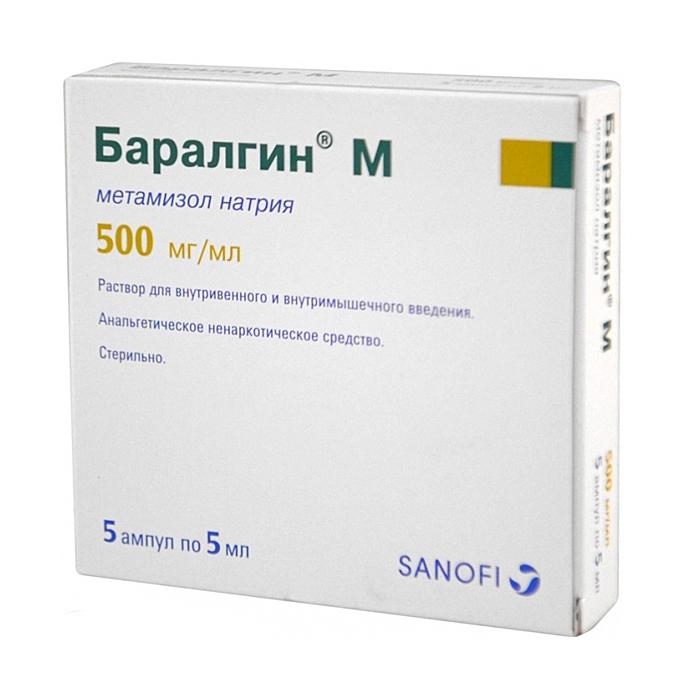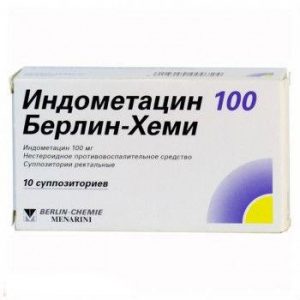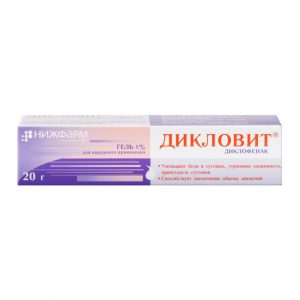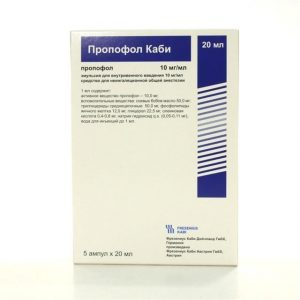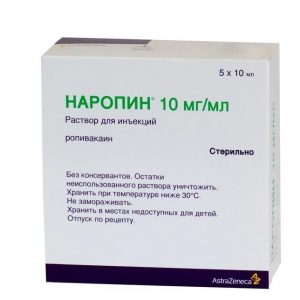Description
Release form
Solution for injection
Packing
5 amp. 5 ml each
Pharmacological action
Baralgin M – NSAIDs, a derivative of pyrazolone, practically does not differ from other NSAIDs in its action mechanism (blocks COX and reduces the formation of Pg from arachidonic acid).
Prevents painful extra- and proprioreceptive impulses from the Gaulle and Burdach beams, raises the threshold of excitability of the thalamic centers of pain sensitivity, increases heat transfer.
A distinctive feature is the slight severity of the anti-inflammatory effect, which causes a weak effect on water-salt metabolism (sodium and water retention) and the gastrointestinal mucosa.
Has analgesic, antipyretic and pronounced antispasmodic (on smooth muscles of the urinary and biliary tract) action.
The action develops after 20-40 minutes and reaches a maximum after 2 hours.
Indications
pain syndrome of low to moderate intensity (headache, toothache, neuralgia, pain with radiculitis, osteochondrosis, arthritis, menalgia),
smooth muscle spasms (renal colic, biliary colic, intestinal colic), infectious inflammatory diseases (as part of combination therapy).
Contraindications
hypersensitivity,
inhibition of hemopoiesis (agranulocytosis, cytostatic or infectious neutropenia),
hepatic and / or renal failure,
hereditary hemolytic anemia associated with glucose-6-glucose-6 deficiency
aspirin asthma,
anemia,
leukopenia.
Use during pregnancy and lactation
Contraindicated in the first and third trimesters of pregnancy.
Use in the II trimester – only for strict medical reasons.
Breastfeeding is contraindicated for 48 hours after taking Baralgin M.
Composition of
1 ml of the solution contains 500 mg metamizole sodium
Dosage and administration of
i / m or iv (especially for severe pain): adults – 250-500 mg 3 times a day. The maximum single dose is 1 g, daily – 2 g.
Children are prescribed at the rate of 5-10 mg / kg 2-3 times a day.
For children under 1 year of age, the drug is administered only in oil. The injectable solution for injection should have a body temperature. Doses of more than 1 g should be administered iv.
Conditions for antishock therapy are necessary.
The most common cause of a sharp drop in blood pressure is an injection rate that is too high, in this connection, the on / in the introduction should be carried out slowly (with a speed of not more than 1 ml / min), in the patient s supine position, under the control of blood pressure, heart rate and the number of breaths.
Side effects of
From the urinary system: impaired renal function, oliguria, anuria, proteinuria, interstitial nephritis, urine staining in red.
Allergic reactions: urticaria (including on the conjunctiva and mucous membranes of the nasopharynx), Quincke’s edema, in rare cases – malignant exudative erythema (Stevens-J syndrome
onson), toxic epidermal necrolysis (Lyell syndrome), bronchospasm shock.
From the side of hematopoiesis: agranulocytosis, leukopenia, thrombocytopenia.
Other: decrease in blood pressure.
Local reactions: with i / m administration, infiltrates at the injection site are possible.
Drug Interaction
Due to the high likelihood of pharmaceutical incompatibility, it cannot be mixed with other drugs in a single syringe.
Enhances the effects of ethanol when used concurrently with chlorpromazine or the like. phenothiazine derivatives can lead to the development of marked hyperthermia.
X-ray contrast agents, colloidal blood substitutes and penicillin should not be used during metamizole treatment. With the simultaneous appointment of cyclosporine decreases the concentration of the latter in the blood. Metamizole, displacing oral hypoglycemic drugs, indirect anticoagulants, ACS, and indomethacin from the protein association, increases their activity.
Phenylbutazone, barbiturates, and other hepatoinducers at the same time reduce the effectiveness of metamizole.
Concurrent administration with other non-narcotic analgesics, tricyclic antidepressants, contraceptive hormones and allopurinol may lead to increased toxicity.
Sedatives and tranquilizers enhance the analgesic effect of metamizole.
Thiamazole and sarcolysin increase the risk of leukopenia.
The effect is enhanced by codeine, histamine H2 blockers and propranolol (slows down inactivation).
overdose
In case of overdose, consult a doctor.
The following symptoms may occur: nausea, vomiting, stomach pain, oliguria, hypothermia, decreased blood pressure, tachycardia, shortness of breath, tinnitus, drowsiness, delirium, impaired consciousness, acute agranulocytosis, hemorrhagic syndrome, hemorrhagic syndrome, , respiratory muscle paralysis.
Treatment: cause vomiting, gastric lavage through a probe salt laxatives, activated charcoal conducting forced diuresis, hemodialysis in the development of convulsive syndrome – intravenous injection of diazepam and high-speed barbiturates.
Storage conditions
In the dark place, at a temperature of 8 25 ° C
Expiration
4 years.
Deystvuyuschee substances
metamizol sodium
pharmacy terms and conditions for prescription
Sanofi-Aventis, France
